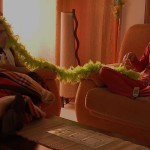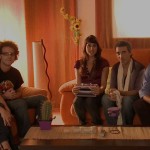Me he perdido
Michael arrives at home after a long night asking for a bed.
In this episode you will learn: how to ask for directions in Spanish, how to give directions in Spanish, how to use specific vocabulary in Spanish, how to make sure someone understands you in Spanish.
MICHAEL: ¿Me podría indicar usted cómo llegar a una cama para poder dormir?
SANDRO: Madre mía Michael, veo que te has pasado con el vodka.
MICHAEL: Un poquito. ¿Y…?
SANDRO: Nada, nada… ¿y cómo has llegado hasta casa?
MICHAEL: Con dos buenas personas. Por cierto, muy guapos. Me han dicho: coge la calle Caspe hasta llegar a Plaza Urquinaona, y una vez allí gira a la derecha y baja por Vía Laietana hasta llegar a la Calle Princesa, y en la calle calle Princesa giras a la izquierda y sigues todo, todo, todo, todo, todo recto, hasta la calle Comerç. Y una vez allí he buscado el número 70, he subido, te he visto y te he preguntado: ¿Cómo puedo llegar a una cama?
SANDRO: ¡Es muy fácil! Mira: coge este pasillo todo recto.
MICHAEL: ¡Voy para allá!
SANDRO: Cuando llegues al final gira a la derecha. ¿Has llegado?
MICHAEL: ¡Ya estoy!
SANDRO: Cuenta tres puertas y entra. Esa es la habitación de invitados
MICHAEL: ¡Gracias guapetón!
ÁGATHA: ¡Michael! ¡Fuera de mi baño! ¡Me estoy duchando!
MICHAEL: ¡Uh! Ya me parecía, esto tiene mucha humedad…
MICHAEL: Might you indicate to me how to get to a bed in order to sleep?
SANDRO: Goodness me, Michael!I see that you’re drunk on vodka.
MICHAEL: A bit. So…?
SANDRO: Nothing, nothing … And how have you arrived home?
MICHAEL: With two good people. By the way, very handsome. I was told: take Calle Caspe until you reach Plaza Urquinaona, and once there, turn right and go down Via Laietana until you reach Calle Princesa, and at Calle Princess, turn left and go straight, straight, straight, straight, straight up to Comerç Street. And once I get there, I looked for number 70, I went upstairs, I saw you and I asked you: How can I get to a bed?
SANDRO: It’s easy! Look: Take this corridor straight on.
MICHAEL: I go there!
SANDRO: When you arrive at the end turn right. Have you arrived?
MICHAEL: I’m here!
SANDRO: Count three doors and enter. That’s the guest room.
MICHAEL: Thanks handsome!
AGATHA: Michael! Get out of my bathroom! I’m taking a shower!
MICHAEL: Uh! It already occurred to me, this has a lot of moisture …
¿Me podría decir cómo llegar a la oficina de turismo?
Could you tell me how to get to the tourism office?
Pay attention to the use of USTED, this is the formal form to talk to someone we don’t know or is older than us and we want to express respect. In Spanish we use USTED and the verb in the 3rd person. Examle: ¿Usted quiere tomar algo? Would you like something to drink?
When we ask for directions we use expressions like:
¿Me podría decir dónde ….?
¿Me podría indicar…? These two are more formal than the following one:
¿Puede usted decirme…?
Te has pasado con el vodka.
You’re drunk on vodka.
We use the verb PASARSE CON + something, when we mean that we have abuse of something. This is quite coloquial.
Coge la primera calle a la derecha.
Take first street on the right.
At this chapter we are learning how to express directions, one of the ways is through IMPERATIVE, a form of the verb. For example: Verb COGER, the imperative form for the second person singular (YOU) is COGE. Other examples are: TOMAR, TOMA, or ABRIR, ABRE. This is for regular verbs. Pay attention! This verb could be used in Spanish of Spain in this case to take a street. NEVER use it in this sense in South America as there it means to copulate in a coloquial way. So, instead of COGER use TOMAR.
Giras a la izquierda.
Turn left.
Previously, we’ve seen the use of IMPERATIVE to give directions, we can also use a PRESENT TENSE. Examples in the chapter: GIRAS, SIGUES, COGES…
¡Guapetón!
Handsome!
This is a way to express gratefulness, fondness and frienship in a very familiar way.


